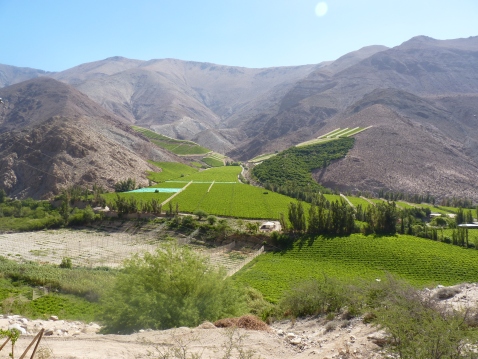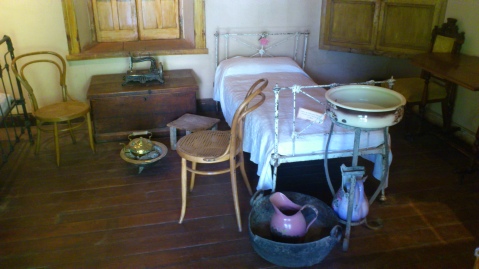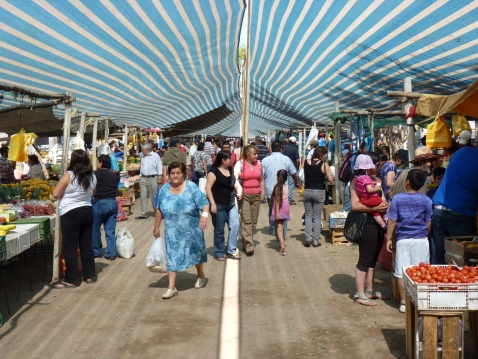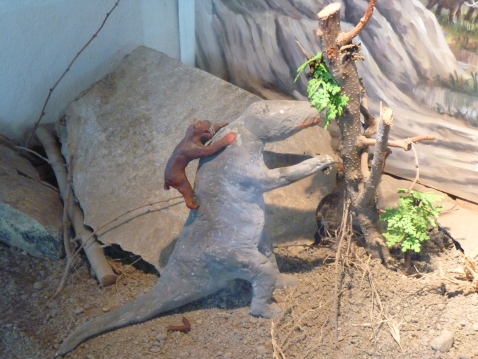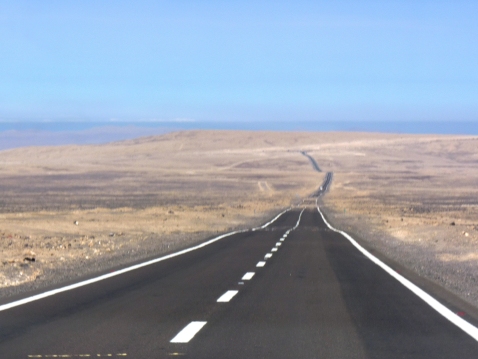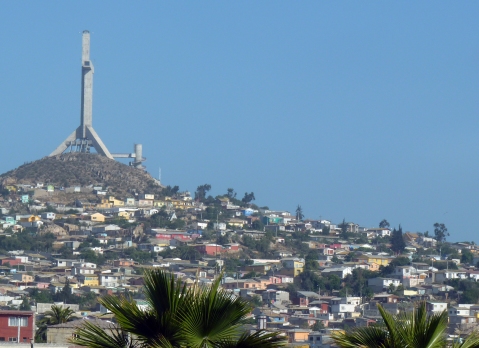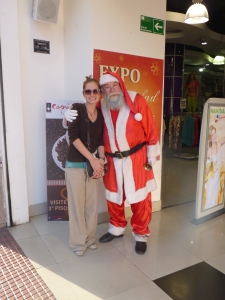Car vs Bikes. Lots of bikes. Bikes win.
Every first tuesday of the month, thousands of Chilean cyclists gather in Santiago and reclaim the streets for the night. The Furiosos Ciclistas (Furious Cyclists) have been peddling across the city 12 times a year since 2004, and growing stronger ever since. There’s a lot of spontanity; cars are just forced to wait if they take a wrong turn through the city. For one night only, motorists have to take the back seat. You can read more (in Spanish) about this excellent protest here
A 10 step Gringo Guide to Getting Internet in Chile
When I first arrived, getting online in Chile was difficult. Especially for someone used to having internet on their phone. Eventually I found a way, but wish I’d had some kind of guide to help make the process smoother. Well, for those coming to Chile, here is that guide…
Hello Gringo! So, you’re heading to Chile and want to surf the information super highway? When you arrive you don’t fancy using the dark, grubby little booths in the internet cafe down some rough looking side street and that ten year old PC in the hostel takes four hours to load hotmail. There’s the wifi cafe, but its miles from where you’re staying and the coffee is terrible.
Bad access to the internet is a problem, as like most gringos, you don’t know how to find something in the real world without Google. Fear not, your troubles are over! With this gringo guide to internet in Chile, you’ll be up and online in a matter of hours (or quite possibly days… or even weeks).
Step 1)
Take a computer to Chile. This can be a laptop, netbook, smartphone. Just take one. You’ll thank me for it. If you don’t take one, buy one. Be warned, laptops also come in Spanish:
Step 2)
Learn how to pronounce ‘Banda Ancha Movil Prepago’ (Baan-da an-cha mow-bill pree-paa-go). Practice. No matter how many times you say it to someone, they will not know what you are talking about. Maybe write it down. Actually, definitely write it down.
Step 3)
Learn what a Banda Ancha Movil Prepago (BAM Prepago for short) actually is:
They come in one shape and size but many different colours. These are the magic sticks that connect your computer to the internet in Chile. They cost around 20000 pesos. The different colours are different companies. They come with a SIM card (like on your mobile phone) that connects you to the internet. It will have credit on it, much like a phone, that allows you internet connection time. The amount of time you get depends on the company.
Step 4)
Try to find a BAM. The first place you will go, which is entirely understandable, is one of the multitude of mobile phone stores in Santiago. This is the last place you should go to look for a BAM. They will look at you incredulously if you ask to buy one. Most people in Chile are only too happy to help you and chat, especially if you try speaking to them in Spanish. Not so in the mobile phone store. People who work in mobile phone stores are the least helpful people in Chile. By far. After 5 minutes of trying to explain what you want, you might finally notice a slight change in their expression, their eyelids might open up slightly for example. They will then mumble something at you and point out of the shop.
Step 5)
Go to a department store! Of course, this is where they sell mobile phones and BAMs. Not in the mobile phone store. That would be all kinds of crazy.
Step 6)
Find an overwhelmingly busy counter, staffed by 10 people all working for different mobile phone companies. Ask one to give you a BAM. They understand! Success. Pay the 20 mil and go home with your BAM. It even includes 10,000 pesos free credit, enough for a week of surfing the web!
Step 7)
Unwrap your BAM, follow the incomprehensible instructions that come with it and struggle for an hour to get the software to work with your laptop. With software installed and BAM plugged in, feel proud to have reached this stage and get ready, finally, to surf the web!
Step 8)
What the hell is a RUT?! I need to enter a RUT to surf the web? Huh? A RUT is the identification number that all Chilean citizens have, and which you don’t have. The Movistar BAM that you bought requires you enter your name, address and a valid RUT before you can get online. No one in the store told you this. Feeling deflated, go back to the store to buy a different BAM (you could try to ask for a refund, but, seriously, I wouldn’t recommend the hassle).
Step 9)
Repeat steps 6 and 7, this time buying a BAM from the company VTR, double checking with the staff that you don’t need a RUT to surf and that it comes with credit.
Step 10)
You have internets! Finally, with your BAM from VTR plugged in and installed, you can at long last surf the web, and find an outlet to rant about your BAM buying experience.
And now the useful bit:
Here’s links to each company’s BAM Prepago offer: Movistar, VTR, Claro, Entel. For what it’s worth, I recommend VTR (IF you are in Santiago, reception isn’t so good outside the city). Movistar requires a RUT. I don’t know about the other two. With VTR you get more bandwidth for your buck (2 gigs per week) and they don’t require a RUT for you to surf.
El Grande Norte 2: Elqui to the Atacama
I can see why the hippies liked the Elqui Valley. An oasis in the desert fed by the Elqui river, this lush valley is surrounded by arid mountain tops silhouetted by famously crystal clear skies. There is definitely an ‘onda’, or vibe to the place. It’s zen. According to the alternative lifestyle seekers who flocked here in the 1960s, it’s actually the centre of the Earth’s magnetism, which shifted from the South Pole to roughly this spot in Chile. While I did feel drawn down the valley, I think this was more because of the aesthetics of the place, rather than its magnetic field. With Gerald at the wheel of our white Nissan Tiida, and his four passengers in tow, we headed upstream to see what all the fuss was about.
The contrast between green vineyards and the rocks beyond is the first thing that hits you, and it is stunning. You can see how the place must have inspired the Chilean poet Gabriella Mistral, who was born here in 1889 in the town of Vicuña, at the opening of the valley, but grew up further upstream in the small village of Montegrande. There is a small museum and statue in this tiny village dedicated to poet, educator and feminist who is still the only Latin American women to have won the Nobel Prize for literature. You get a chance to peer into the original bedroom of the young Gabriella (born Lucila Godoy Alcayaga), read original letters and samples of poetry. Sadly my Castellano is not of a high enough standard to appreciate the literature, so a return visit might be necessary. A few signs of the alternative folk who made a life here is still evident, like the dreadlocked couples selling Mapuche symbols carved from gourd skin. Generally they must be tucked away further up the valley. Most of the people we encountered were tourists, Chilean and Gringo, more interested in Mistral than magnetism.
Heading back out of the valley you reach Vicuña (not to be mistaken for one of these guys), a more lively town with a busy market and large Plaza de Armas (try and find a town in Chile without one). If you have time you can arrange a visit to an observatory for a few thousand pesos, with transport provided and see the stunning night sky through a scope. With little time we had to remain Earth bound, visiting instead a fascinating, albeit dusty entomology and natural history museum on the south side of the plaza. This had an impressive collection of semi-precious stones and seashells from around the world and some inspiring displays:
As you travel north away from the Elqui Valley you start to enter the Atacama proper. This is where the north of Chile starts getting weird. The Pan-American highway, the artery through which almost all of Chile’s goods, people, food and beer flow, runs like a line of hot treacle across this arid expanse. The scale alone impresses. Tiny specs in the distance take 15 minutes to reach you, becoming vast trucks loaded with anything from sulphuric acid for the copper mines, to beer, for…well, probably the copper mines… and everyone else who lives in this barren place. Beer does seem to be the lifeblood of this part of Chile. Almost every other truck is a Crystal truck.
Yes, the Crystal highway ensures that even on the driest place on earth, beer is within easy reach. Having spent two weeks in this place, you can understand the urge to drink. It’s barren. Sure, the landscapes are stunning. Beginning with undulating red and golden hills you slowly creep upwards and northwards onto vast flat plains with the white foothills of the Andes shimmering in the distance. But there is nothing here. A rock stands out as a point of interest. Something to go and look at! The road itself is the most interesting thing to marvel at. The way it crawls on, unforgiving, through plain, mountain and valley with nothing to support it but itself. How they ever built this thing out here is beyond comprehension.
A few hundred miles north of La Serena the road takes a rare turn and heads for the coast. Just as you become accustomed to the bareness of the desert, as the road winds down valleys towards the pacific you are hit with a dose of something unexpected. Bleakness. Yellow sun, white desert and golden hills I can handle. Grey skies, grey rock, grey sea, I cannot. The coast from here to Iquique is blanketed by an almost permanent layer of thick, low cloud, washing out the colour palate of the desert and creating a land of monotone. It was here, during a night in the small town of Taltal, that food poising took us by surprise and the journey north seemed its bleakest yet…
El Grande Norte 1: Santiago to La Serena
I was hanging out of the rear window of our hire car. The desert stretched out in every direction as far as the eye could see, the volcanic Andes to our east, the slowly descending plains to our west. With my torso out of the window, I could angle myself to examine the deflated rear tyre we were now driving on. Every few seconds I was shouting to Gerald, our driver, that it was still holding on… just. After about 5 km of this, speeding along a dirt track through the Chilean Altiplano, 100 miles from anywhere, I watched the tyre slip off and roll to the distance, settling next to a large rock. Shouting at Gerald, we ground to a halt, the car resting on its steel wheel rim. We watched the sun start to lower in the sky towards the volcanic horizon. It was our spare tyre. We had no replacement. Perhaps this road trip around the north of Chile wasn’t such a good idea.
Chile is long. It is so long, that if you tore it up from the crust of the Earth and laid it over Europe, despite causing immense destruction, it would reach from London to Baghdad. Gerald, a friend of my girlfriend’s father who was visiting from France, decided he wanted to drive through the northern half of it. In a Nissan Tiida. This is a family saloon car designed for day trips on paved roads and inter-city hops, not a 2000 mile road trip through one of the most inhospitable landscapes on Earth. Despite this, Gerald, along with his wife, my girlfriend, her father and I, decided this sounded like a good trip. Having just arrived in Chile my girlfriend and I had no immediate plans. A chance to be driven around the Atacama desert, the driest place on Earth, was an opportunity not to be missed. The trip would take us 1000 miles north from Santiago, stopping at various towns and cities on the coast along the way, to Arica, a city just south of the border with Peru. We would then return south along a more winding route further inland, through the high plains or Chilean Altiplano. The transition in landscape is subtle and slow but the eventual difference between places extreme.
We set off from central Santiago and after a gruelling two hours of dense traffic we eventually escape onto the Pan American Highway, the paved artery that connects Chilean Patagonia with Alaska, if you drive far enough. Heading north through the low rise hinterlands and the industrial areas the city slowly gives way to the Mediterranean-like scrubby low land. After a few hours driving we reach La Serena. This coastal city is a tourism hub for Chileans, a summer escape for the people of Santiago to the cooler sea air and sandy beach. Opting to avoid the city itself for somewhere to stay, we find a cabaña near Coquimbo, a densely packed peninsular just south of La Serena that overlooks the city and its wide bay. Coquimbo is a less friendly tourist spot than La Serena itself, but worth visiting. It’s a quiet place with tightly packed streets and colourful ramshackle old houses. They wind around a steep hill, leading towards an immense concrete building in the form of cross. This monument to the Christian faith, one of the largest in South America, was opened in 2000, representing the Third Millennium of Christ. You literally can’t miss it, which is unfortunate, as it’s horrendously ugly. I’m not a man of faith though. Believers may take a different view.
The next day we ventured into La Serena. The city has a pleasant Plaza de Armas, or central square, surrounded by Spanish colonial buildings. Its tiled pavements and streets lead off into busy shopping districts, with the usual mix of department stores, clothes shops, pharmacies and artisanal markets. Being just a few weeks before Navidad (Christmas) it was packed, and we even got a chance to meet Father Christmas. The real attraction of La Serena is its huge beach which gently curves north for 10 miles. Unfortunately, this being the Pacific there is the ever present Humboldt current carrying ice cold water from the Antarctic Ocean north along the coast of Chile. This doesn’t put off reams of Chilean visitors, who after a dip in the ocean treat themselves to tasty sweet snacks like tortas, dulces de la ligua and helados, all sold by men who walk the length of the beach carrying their goods on huge trays or in polystyrene boxes.
Inland from La Serana, there are beautiful valleys tucked away across this region, hiding incredible oases. These microclimates are used to grow the Pisco grape, the infamous national liquor of Chile. The Elqui Valley, birthplace of Nobel prize winning author Gabrielle Mistral, is one of the most spectacular. Dense green cultivated patches of land hug tightly to the river in the bottom half of the valley, the farmers irrigating the land as far uphill as gravity will allow. The green then suddenly gives way to barren white and yellow rock, bare mountain tops leading to the desert beyond…
Next post: Mistral and Markets in the Elqui Valley, the Pan American (or Crystal Highway) and food poisoning along the bleakest coast on Earth.
10 things you probably don’t need to know about Chile
Here are ten observations about Chile for the uninitiated:
1) Chileans like to eat. A lot. Even their drinks have food in.
They get lunch and dinner the wrong way round. Lunch is a huge, 3 course meal. Dinner is sandwiches and cake, with tea (they call it ‘onces’, which is derived from the English ‘elevenses’, even though you have it anywhere between 6pm and 10pm. Hmm.)
2) More than anything, Chileans like to eat pan. That’s bread to you and me. This is not unusual in Chile:
Oh, and avocados. Just don’t say to a Chilean, “Me gusta comer avocados”. They’ll think that you like to eat lawyers. Which probably isn’t such a bad thing. Avocados are called paltas. Learn that word, you will hear it a lot.
3) Chileans don’t drink. They make all this amazingly lovely wine and vast quantities of lager, which they sell for peanuts, and then they don’t drink it. I’ve been to parties, BBQ’s and even pubs and most of the adults there are drinking bebidas (soft drinks!). Ok, ok, so they might have a small glass of wine, or half a can of beer with a meal. But they don’t drink, not like the English. This is a tough one to adjust to. I drank a can of beer in the park one day* and people looked at me like I was a crazed alcoholic. Maybe I should have put some clothes on.
4) Chilean people are really lovely**. Families are closer and people are more affectionate here. Touching is good, and encouraged. Especially on the metro where it is unavoidable. You can’t walk through a park without seeing dozens of couples, of various ages, kissing.
5) Dogs are EVERYWHERE in Chile. Dogs that are owned by someone tend to be small and white:
Dog’s that aren’t owned by someone tend to be brown and kind of creepy:
6) Chileans do everything slowly, calmly, and without sign of anger or frustration. Except driving. Put a Chilean behind a steering wheel and they are transformed into an ADHD racing driver with a redbull habit. In England I never, ever, saw a car accident actually happen before my eyes. In 3 months here I have seen four.
7) It’s impossible to get lost in Chile, even without Google Maps. Andes on the right when facing north. Andes on the left when facing south. If you’re hot, walk south to Santiago. If you’re cold, walk north to Santiago.
8) Chile was founded by an Irishman (well, half Irish) named Bernard. He had ginger whiskers and everything.
9) The television is truly awful. There are roughly 10 Chilean TV celebrities who take it in turns to sit on sofas to talk about the other 8 or 9 Chilean celebrities. Thankfully people here spend more time eating and talking with their families than watching TV, so this isn’t as much of a problem as it would be in England.
10) Don’t expect to be able to understand anyone here for at least 6 months. Even if you speak Spanish. Chileans don’t speak Spanish, they speak Chilean.
*Ah, apparently its illegal.
**Except for punks. Punks don’t seem to like extranjeros (foreigners), which is why they spit at you.
Next post I’ll update on the mission to El Grande Norte, which included, among other things: meteor craters, the world’s biggest copper mine (its BIG), valle de la luna, endless lifeless expanses of desert, driving on three wheels through the Altiplano salt flats and a night on the floor of a remote Argentinean border post. Hasta luego amigos.
Chile: Land of Opportunity?
The view from my apartment has changed in the three months since I arrived in Santiago, Chile’s capital and one of the biggest cities in South America. Chile’s sustained and increasing economic growth rate is transforming the skyline of this city. From the balcony I can see the continent’s tallest building, the Gran Torre Costanera, a great neoliberal monolith watching over the continent’s largest shopping mall (which is scarily huge). In every direction the city is awash with cranes… old neglected buildings of a previous colonial age swept aside for spotless new tower blocks that mark a new colonial era, one of increasing foreign immigration and investment.
An immigrant myself, I’m part of a growing trend of young Europeans escaping the financial crisis, triple dip recession and austerity that is depriving a generation of hope for the future. For many young Europeans, like the USA a century ago, it seems South America is the new promised land, and Chile is among the top destinations. The situation in Europe is in stark contrast to that in South America. Leaving a cold, damp and depressed London for a bright, warm and positive Santiago, it is hard not to be uplifted by daily headlines of increasing growth rates and record levels of employment (Unemployment in Santiago hit a 40 year low, just 5.2%, in December). Chile’s economy is booming on the back of its commodities, especially copper. It’s the world’s biggest supplier, and primarily exports it to China for use in the burgeoning consumer electronics market and construction industry. The vast Minera Escondida, the biggest single producer of copper in the world, accounts for 4% of Chile’s GDP alone.
The upturn in South America’s economic fortunes is bringing an increasing geopolitical importance with it. Marking this shift in global power relations, January saw Chile as host of the first summit of the European Union with CELAC, the Community of Latin American and Caribbean States. Angela Merkel and Mariano Rojoy were among 45 heads of state meeting to boost bilateral trade and institutional cooperation between the two blocs. The only two American nations absent from the summit were the United States and Canada. In a diplomatic coup for President Castro, communist Cuba, still suffering from a 50 year long trade embargo by the USA, was among the Latin American nations present. Latin America seems to be finally getting its place at the geo-political power table (another indication of this, of course, is the first South American Pope).
You can forget in this climate of economic and financial positivity that not everyone is able to join the party. Chile has the highest Gini coefficient, a measure of inequality, for any OECD country. According to Techo, a non-profit tackling slum poverty in Chile, 41% of people were estimated to be living in extreme poverty in 2004. The tensions between those that have entry to the economic party, and those that don’t, is ever present. The well known student protest movement against unaffordable education is part of a continuing resentment of the young against the legacy of the Pinochet era and experiments in extreme free market economics. This legacy can be seen in the private ambulances that drive through the streets and the mothers who sell sticking plasters to wealthy surburbians to get by. It can also be seen in the dusty ‘campamentos’, or tent cities, on the outskirts of the city, where families have no access to drinking water or electricity. For an idea of small government and reliance on the market to serve society, look no further than Chile. Some people do just fine, thank you very much….others aren’t so fortunate.
With this tension, something has to give. The break-neck development in Chile is not sustainable when it is so inequitable. Inequality is not just bad for the people, but it is bad for investment. There are signs that the political class is beginning to understand this. The theme of the EU-CELAC Summit was promoting an alliance for sustainable development, with investments in social and environmental quality. Meanwhile, a big section of Chilean society, especially youth, is ahead of its political counterparts, increasingly intolerant of the inequality that impacts all their lives. During the EU-CELAC, a 1000 strong protest march calling for free education and environmental protection was run by an alternative people’s summit. There is also ongoing and overwhelming national support for the student protest movement and approval ratings for the billionaire centre-right President Sebastián Piñera have been as low as 22%. Michelle Bachelet, a popular social democratic president forced out of power due to Chile’s constitutional arrangements, would be enthusiastically welcomed back by many Chileans in elections taking place this year.
The people of South America, and Chile in particular, have the potential to learn a lesson from the fallout of Europe and the USA’s 30 years of neoliberalism, which Chile (largely against the people’s will) found itself a pioneer of, and which Europe is still encouraging. The Chilean people have a chance to leverage the country’s current economic success in the fight against inequality. I don’t think it will be an easy task, but as a victim of the impacts of economic policies in my own continent, fortunate enough to move somewhere new, I am hopeful that the better economic fortunes befalling a new generation here will be used to build a brighter future for everyone.




